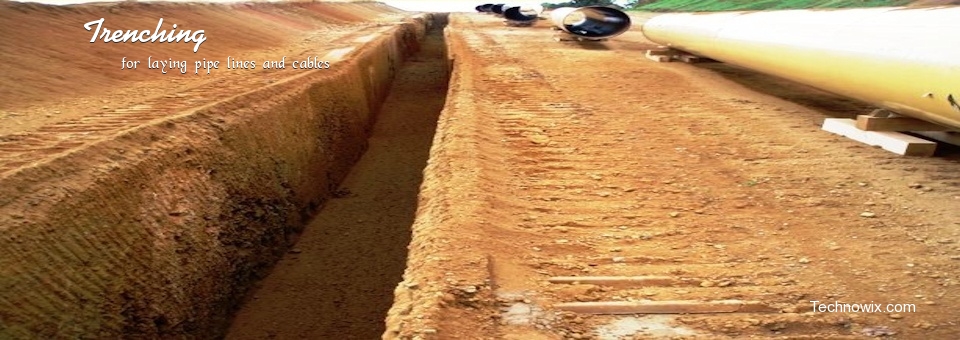TECHNOWIX INFRA DEVELOPMENT (P) LIMITED
(A Contractor Company of Civil,Mechanical,Electrical and
Structural Engineering Projects)
C.I.N.: U74120UP2012PTC051143

Open Trench
In the civil engineering field of construction or maintenance of infrastructure, trenches play a major role. They are used to place underground easily damaged and obstructive infrastructure or utilities (such as gas mains, water mains or telephone lines)
Trenching, ducting and backfilling
Excavation of Trenches Standard depth of trench will be as per specifications Outside the city limits trench will normally follow boundary of roadside land.
However, where road side land is full of borrow pits or forestation, or when cable is to be laid along Culverts/bridges or cross-streams, trench may be
made closer to road edge or in some cases, over embankment or shoulder of the road.
Line up of trench would be such that HDPE duct(s) will be laid in straight line, both laterally as well as vertically except at locations where it has to
necessarily take a bend because of change in alignment or gradient of trench. Minimum radius of two meters will be maintained, where bends are
necessitated.
Duct Laying Method
Ducts will be laid in a flat bottom trench, free from stones, and sharp edged debris. The duct would be placed in trench as straight as possible, however
at bends horizontal and vertical minimum bending radius for duct would be maintained as per advised specifications.
Ducts will be laid preferably using dispenser designed for it. Our supervisor will ensure that Duct laid is free from twist and collapsed portion of Ducts.
Any such portion will be rectified before backfilling by using couplers. Ends of ducts will always be closed with END PLUGS to avoid ingress of mud,water or dust.
We ensure HDPE ducts are clear of sand, dust or any other particles, which would cause obstruction in lying of cable. Prior to aligning the ducts for
jointing, each length of the HDPE ducts will be thoroughly cleaned to remove all sand, dust or any other debris that may clog, disturb or damage the
optical fiber cable when it is pulled or blown at a later stage. The ducts will be joined with couplers using duct cutter & other tools and will be tightened and secured properly. The duct joint will be practically airtight to ensure smooth cable blowing using cable blowing machines.
Laying of Gl and / or RCC pipes as additional protection for the HDPE ducts at rail / road crossings, built-up area/city limits, on culverts and bridges will be
done as required. Chambering or concreting around RCC/ Gl pipes as additional protection on bridges, culverts and also on stretches wherever
depth of excavation is less than specified will be done.
Reinstatement of excavated trench will be done with proper compaction. Crowning When backfilling has been done up to ground level a hump of soil is
made to cater for soil settlement. Entire excavated soil will be used for back filling. Crowning will be confined over width of trench only
Note:- We take all the
Safety Precautions in Trenching Operations as per operation
manual.
*Horizontal Direction
Drilling *Open
Trench *Machinery *Tools & Equipment
*Company Profile
*Network
System Setup *Career
*Employee Login
Copyright © 2011 Real Maxx Group. All Rights Reserved | realmaxx@gmail.com